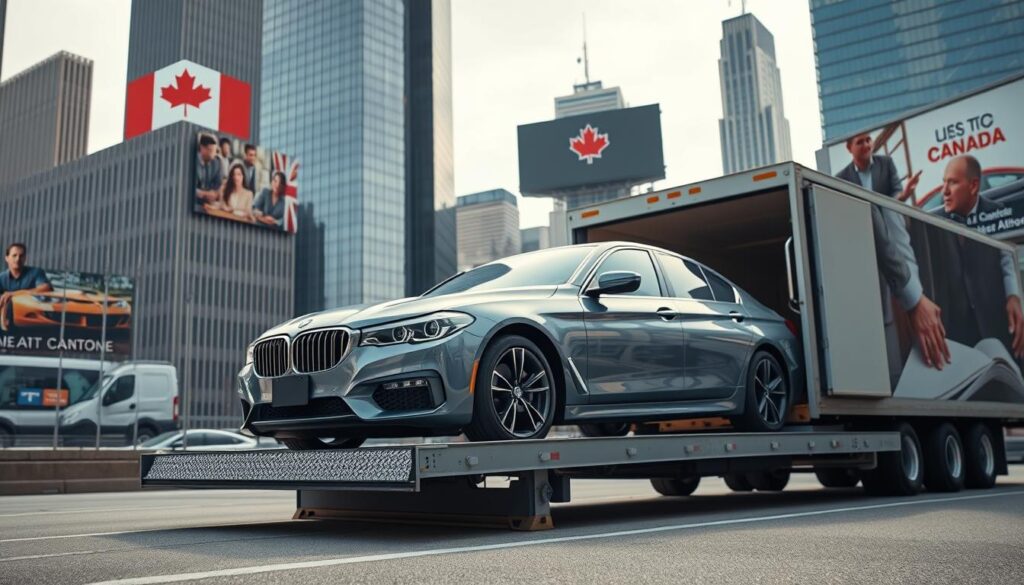Curious which costs add up when a vehicle moves across the border? Many owners assume carrier fees are the whole story. In truth, taxes, duties, RIV fees, inspections, and possible modifications raise the final bill.
This section frames the total cost picture and explains why precise quotes need origin, destination, vehicle details, transport method, and a delivery window. Those items drive price bands and transit time.
Typical ranges today show open carriers as the lowest-cost option, enclosed carriers for high-value autos, and driveaway for urgent delivery. Expect transit from three to ten days depending on method.
Ask for a written estimate that lists carrier charges, insurance, and likely border fees. A reputable company will explain each line, protect the vehicle in transit, and manage documentation.
Key Takeaways
- Get a written quote with transport method and estimated border charges.
- Open carriers cost less; enclosed carriers protect higher-value vehicles.
- Border fees can include GST, provincial taxes, and possible duties.
- RIV fees and inspections add to the total budget.
- Compare providers and confirm insurance and timelines before booking.
What Affects the Cost to Ship a Car from the USA to Canada Today

Price hinges on a handful of predictable items: miles, vehicle size, transport method, and season.
Distance drives fuel, driver hours, and routing complexity. Exact pickup and delivery ZIPs let a company provide accurate shipping rates and realistic transit time. Typical transit ranges run 3–10 days depending on lane and method.
Vehicle type and size change space allocation on a truck. SUVs and oversized vehicles cost more than compact autos. Modified or lowered vehicles may need special handling and extra charges.
Transport method sets the protection and the price. Open truck service usually runs about $800–$1,000 for standard vehicles. Enclosed transport suits luxury and classic autos and commonly lists near $1,200–$1,400. Driveaway options fall around $1,000–$1,800 when available.
Season and intent matter. Snowbird peaks tighten capacity and raise rates. Permanent import requires taxes and RIV work; temporary stays may change paperwork needs.
- Accessibility, rural vs. metro lanes, and pickup windows add cost or convenience.
- A professional service will list included coverage, optional add-ons, and timing windows.
- For specialty shipments, enclosed transport is recommended during harsh weather or tight timelines.
Contact Best Car Shipping Inc. at (307) 288-5972 or info@bestcarshippinginc.com for a written quote tailored to your vehicle, distance, and schedule.
how much to ship car from usa to canada

Build a realistic total by adding precise line items for transport, taxes, and compliance. Start with the chosen transport method and its rate range. Then add regulatory charges and any modifications required for admissibility.
Quick estimate builder: transport, taxes, duties, RIV, inspections, and modifications
List each line item: transport (open $800–$1,000; enclosed $1,200–$1,400; driveaway $1,000–$1,800), GST (5% on declared value), provincial tax, and possible 6.1% import duty for non‑USMCA vehicles.
Add fixed fees: RIV fee about $341.25 and any provincial inspection or registration charges. Include the $100 AC tax when applicable.
Sample totals using common scenarios and routes
Example: a standard sedan on open transport (~$900) plus DRL $250 and metric speedo $250 gives a $1,400 subtotal before taxes and fees. Apply GST, provincial sales tax, RIV, and duty for a realistic bottom line.
When quotes vary and how to compare services
Quotes differ because carriers assume varied pickup windows, rural access, insurance limits, and loading difficulty. Ask providers to itemize rates, taxes, duties, and any admin or storage fees.
- Confirm goods services and services tax assumptions.
- Verify auto shipping coverage matches vehicle value.
- Request a written, itemized estimate with transit window and contingencies.
For a written shipping car canada quote, contact Best Car Shipping Inc. Call (307) 288-5972 or email info@bestcarshippinginc.com.
Government Taxes and Duties at the Border
Border levies and provincial charges often add more to the invoice than transport alone. Importers must calculate federal and provincial layers before finalizing a budget.
Goods and Provincial Sales
Apply goods services tax at 5% of the declared vehicle value at entry.
Then add the provincial sales component based on the registration province. Examples: Ontario (HST 8%), Quebec (QST 9.975%), B.C. 7%, Saskatchewan 6%, Manitoba 7%.
Import Duty and USMCA Exemptions
USMCA-origin vehicles are typically exempt from import duty. Non‑USMCA vehicles usually face a 6.1% import duty on value.
Keep origin documentation ready. Missing evidence can trigger duty assessments and delay clearance.
Other Specific Taxes and Fees
Fixed charges include a $100 air conditioning tax when equipped. Vehicles over 2,007 kg may trigger excess weight tax for certain truck and larger vehicle classes.
Fuel‑inefficient cars face gas guzzler penalties: 13–14L/100 km = $1,000; 14–15L = $2,000; 15–16L = $3,000; 16L+ = $4,000.
Luxury and High‑Value Vehicles
High-value vehicles can attract additional luxury levies. Thresholds often sit near CAD 100,000 with tiered calculations that raise the overall tax cost.
- Tip: Include GST, provincial sales, any duty, and fixed fees in early quotes to avoid surprises.
- Tip: Best Car Shipping Inc. can pre-screen taxes and provide a line‑item estimate—call (307) 288-5972 or email info@bestcarshippinginc.com.
Registrar of Imported Vehicles: Fees, Standards, and Timing
Registering a vehicle with the federal importer program starts the compliance timeline and sets predictable costs. The Registrar program requires a one‑time RIV fee of about $325 plus GST—roughly $341.25 total. This covers federal processing and gives access to the inspection instructions you will need.
RIV fee, what it covers, and provincial inspection basics
The RIV charge covers documentation review and clearance guidance. After RIV, owners book province‑level inspection.
Expect variable local costs: Ontario Safety Standards Certificate runs about $60–$150; New Brunswick inspections near $35–$45; Alberta insurance inspections commonly cost about $100 for a car.
Admissibility and safety standards alignment (CMVSS)
Admissibility depends on alignment with Canadian Motor Vehicle Safety Standards. Minor fixes — daytime running lights or a metric speedometer — are common. Confirm standards early so parts and labor do not delay the process or add storage charges.
Recalls, documentation, and rejection risks
All safety recalls must be closed before import. Keep title, bill of sale, ID, and recall letters ready. Ineligible vehicles or major noncompliant modifications can trigger RIV rejection and forced export at owner expense.
- Tip: Itemize RIV and provincial inspection fees on estimates so owners see full costs.
- Tip: Best Car Shipping Inc. coordinates RIV steps and schedules inspections to reduce time and risk; call (307) 288-5972 or email info@bestcarshippinginc.com.
Transport Methods, Insurance, and Rates from the US to Canada
Selecting the proper carrier and equipment has the greatest impact on final rates. Choices set transit time, protection level, and total cost.
Open vs. enclosed and driveaway options
Open carriers are the most economical for standard vehicles. Typical ranges run $800–$1,000 with 7–10 day transit, depending on distance and lane.
Enclosed auto shipping suits luxury or restored autos. Expect $1,200–$1,400 and 5–7 day transit for added weather protection.
Driveaway service can be faster (3–5 days) but adds mileage; prices vary $1,000–$1,800 and depend on route availability.
Insurance basics and GAP considerations
Carriers include cargo liability, but limits differ. Confirm the carrier’s cap and compare it to the vehicle’s insured value.
Supplemental or GAP coverage is recommended for high‑value autos when the carrier limit is lower than replacement value.
| Method | Typical Cost | Transit |
|---|---|---|
| Open carrier | $800–$1,000 | 7–10 days |
| Enclosed | $1,200–$1,400 | 5–7 days |
| Driveaway | $1,000–$1,800 | 3–5 days |
Best Car Shipping Inc. documents pickup condition, issues a bill of lading, and delivers written, all‑in rates. Call (307) 288-5972 or email info@bestcarshippinginc.com for a tailored quote.
Paperwork and Border Process: From Title to Customs
Timely paperwork and clear border contacts keep vehicle transfers moving without surprise holds.
Submit the title and supporting documents to the specified crossing about 72–80 hours before export. Confirm receipt with the border contact your carrier provides.
Title submission windows and contact coordination
List the contact name, phone, and hours on the dispatch sheet. Align arrival time with the crossing window to avoid parking or storage fees.
Essential forms and prechecks
Prepare an original title or certified copy, bill of sale, photo ID, and recall clearance. Verify the VIN on every form.
- Confirm whether HS-7 or EPA paperwork applies and have current versions ready.
- Complete required inspection work before arrival; open recalls delay clearance.
- Decide electronic or physical delivery and meet the facility cutoff.
Best Car Shipping Inc. manages timelines, confirms border coordination, and supplies milestones during the process. Call (307) 288-5972 or email info@bestcarshippinginc.com.
| Step | Action | Why it matters |
|---|---|---|
| Title submission | 72–80 hours prior | Prevents holds at the border |
| Document packet | Original title, ID, bill of sale | Speeds customs review |
| Regulatory forms | HS-7 / EPA if needed | Ensures legal import |
| Inspection & recall | Complete before arrival | Avoids delays and extra fees |
Is It Worth Shipping or Driving? Cost, Time, and Vehicle Wear
Deciding whether to drive or arrange professional transport starts with a clear comparison of all expenses.
Break-even examples: Open transport for long distance often runs CA$1,000–$1,200. A self-drive run may show CA$800 in fuel, hotels, meals, and basic service. After factoring depreciation at about CA$0.50 per mile and tire wear, the true cost often favors paid transport.
Hidden driving costs include lodging, meals, extra washes, and a post‑trip tune up. These add up fast and increase risk exposure on long routes.
When importing is sensible
Import decisions make sense for rare models, rust‑free southern cars, or vehicles older than 15 years. Older units may avoid some RIV steps and standards work, lowering compliance time and expense.
When to avoid importing
Avoid bringing common models available locally. Added tax, metric conversions, and resale discounts often erase savings. If towing extra cargo with a truck, fuel consumption rises and total driving cost climbs.
- Tip: Shipping keeps mileage off the odometer and protects resale value.
- Tip: Best Car Shipping Inc. can run a side‑by‑side comparison for your route. Call (307) 288-5972 or email info@bestcarshippinginc.com.
Conclusion
Successful imports finish with an itemized plan that covers transport, taxes, and required compliance steps.
Build a final budget that lists carrier rates, GST at 5%, provincial levies, possible 6.1% import duty for non‑USMCA vehicles, the RIV fee (~$341.25), inspection costs, and minor modifications.
Choose open carriers for value or enclosed units for added protection depending on vehicle value and risk tolerance.
Submit title documents within the 72–80 hour window and confirm border coordination to avoid storage fees and delays.
For clear, written estimates that itemize duties and fees, contact Best Car Shipping Inc. at (307) 288-5972 or info@bestcarshippinginc.com.
